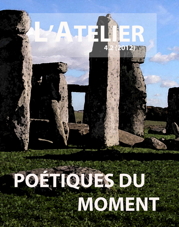« Something flickers and dances. » L'écriture à la rencontre de la danse : Poétique du moment dans The Waves et The Years de Virginia Woolf
Résumé
The Waves (1931), roman dit « expérimental », est encensé par la critique autant que The Years (1937), saga familiale dite « réaliste », est décrié ou ignoré. Cet article avance pourtant que ces deux romans illustrent la continuité de la quête woolfienne d'une poétique du moment, poétique qu'ils esquissent à la rencontre de la danse, selon des modalités proches. Loin de se résumer à une série de vignettes ornementales et thématiques, la danse participe, dans ces deux romans, à l’expérimentation d’une écriture qui cherche à représenter le « moment présent », qui s'abolit aussitôt qu'il émerge, ou plutôt son creusement qui actualiserait la quête impossible d'un monde que ne percevrait aucune conscience, ce « world seen without a self » (The Waves 192) que cherche Bernard, l’écrivain.
Faisant l'hypothèse que la théorie contemporaine de la danse peut éclairer la lecture d'une œuvre de fiction, cet article montre comment la poétique propre à ces deux romans invente une mise en relation architecturale du corps à un espace par la danse ou par la marche, ainsi qu'une écriture du moment comme tenue de rythmes autonomes, du moment comme saut, comme intermittence, comme ce « apparaître-disparaître incessant » (Fontaine) ou ce « rester-à-disparaître » (Fabbri) de la théorie contemporaine de la danse. Il apparaîtra enfin que cette poétique du moment relève d'une tentative de dépersonnalisation du monde proche de celle que Gilles Deleuze attribue aux comédies musicales, quand le cinéma qui danse aide le philosophe à penser le mouvement et le temps.
The Waves (1931), which is considered the epitome of Woolf's « experimental » novels, has been praised by academia just as The Years (1937) has been overlooked or despised for its alleged « realistic » theme and structure. This article argues, however, that both novels partake of Virginia Woolf's search for a poetics of the moment which they create as they gesture towards dance. In these novels, dance is not the mere matter of thematic vignettes; rather The Waves and The Years resort to dance to express « the present moment » as well as its disappearance, or rather to hollow it out and write a world that no conscience would perceive, the « world seen without a self » (The Waves 192) that Bernard, the writer, is looking for.
Reading the two novels in relation to contemporary dance theory, it is suggested, sheds light on their poetics. Both articulate body to space through dancing and walking, that this architectural co-presence partakes of a poetics of the moment that consists in holding together individual rhythms, in abolishing what is sketched at the very moment when it emerges, an « incessant appearance-disappearance » (Fontaine), something that « remains to disappear » (Fabbri), to quote from modern dance theory. Finally, in these novels, Woolf's poetics of the moment strives to achieve what Deleuze calls « depersonification » of the world in musical comedies, when cinema dances and helps the philosopher think movement and time.
-
L’envoi spontané d’un article à la rédaction de L’Atelier implique l’autorisation de publication et la cession des droits dans les limites établies par la loi de propriété intellectuelle.
-
L’Atelier conserve les droits de reproduction des articles publiés, quelque soit le support : internet, CD ROM, réimpression, photocopie, etc.
-
L’auteur conserve le droit de publier ultérieurement son article déjà paru dans L’Atelier avec la seule obligation de mentionner le nom de la revue comme source de la première publication.





